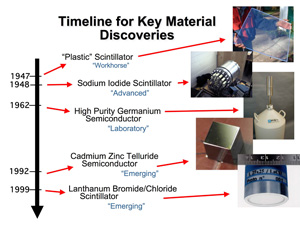Home > Press > You can't teach old materials new tricks
 |
| Timeline for key radiation detection material discoveries. |
Abstract:
Decades-old challenge has researchers seeking new materials for radiation detection
You can't teach old materials new tricks
BOSTON, MA | Posted on February 16th, 2008A more sensitive, more selective and easily deployable radiation detection material is necessary to meet complex 21st century challenges. In the AAAS symposium "Radiation Detectors for Global Security: The Need for Science-Driven Discovery," researchers addressed some of the technical challenges and gaps and proposed a science-driven approach to uncovering novel materials that will benefit national security and medicine.
"Until now, it can be argued that we've approached the challenge in an Edisonian-style; I think it's time to make a drastic change in how we pursue solutions to radiation detection," said Anthony Peurrung, director of the Physical and Chemical Sciences division at Pacific Northwest National Laboratory. "In order for us to make new discoveries, we need to improve our understanding of radiation physics so that we make educated choices about which materials will and will not perform as we need them to, thus working more efficiently toward a solution."
Five primary materials are used for radiation detection, but they all have limitations, such as small size, challenges in manufacturing, poor discrimination of radionuclides and poor sensitivity. For example, single crystalline materials, used as semiconductors or scintillators, generally provide the highest sensitivity and best energy resolution. But, it can take a decade or more to develop high-quality, single crystals that are of sufficient size for use as radiation detectors, and there are a limited number of manufacturing facilities to produce the crystals.
Peurrung leads PNNL's Radiation Detection and Material Discovery Initiative, which is a three-year, $4.5 million research effort aimed at discovering new materials for radionuclide identification, accelerating discovery processes and improving our fundamental understanding of radiation detection.
Bill Weber, a Laboratory Fellow, organized the symposium. He is a AAAS fellow and is internationally recognized for his seminal scientific contributions on the interaction of radiation with solids and radiation effects in materials.
The symposium was held at the 2008 AAAS Annual Meeting in Boston, Mass., on Saturday, February 16, 2008, at 10:30 a.m. Other speakers included Bill Moses, Lawrence Berkeley National Laboratory, Kanai Shah, Radiation Monitoring Services, Inc. and Lynn Boatner, Oak Ridge National Laboratory.
####
About Pacific Northwest National Laboratory
PNNL is a DOE Office of Science national laboratory that solves complex problems in energy, national security and the environment, and advances scientific frontiers in the chemical, biological, materials, environmental and computational sciences. PNNL employs 4,000 staff, has a $760 million annual budget, and has been managed by Ohio-based Battelle since the lab's inception in 1965.
For more information, please click here
Contacts:
Andrea Turner
(509) 375-3893
Copyright © Pacific Northwest National Laboratory
If you have a comment, please Contact us.Issuers of news releases, not 7th Wave, Inc. or Nanotechnology Now, are solely responsible for the accuracy of the content.
| Related News Press |
News and information
![]() Simulating magnetization in a Heisenberg quantum spin chain April 5th, 2024
Simulating magnetization in a Heisenberg quantum spin chain April 5th, 2024
![]() NRL charters Navy’s quantum inertial navigation path to reduce drift April 5th, 2024
NRL charters Navy’s quantum inertial navigation path to reduce drift April 5th, 2024
![]() Discovery points path to flash-like memory for storing qubits: Rice find could hasten development of nonvolatile quantum memory April 5th, 2024
Discovery points path to flash-like memory for storing qubits: Rice find could hasten development of nonvolatile quantum memory April 5th, 2024
Laboratories
![]() A battery’s hopping ions remember where they’ve been: Seen in atomic detail, the seemingly smooth flow of ions through a battery’s electrolyte is surprisingly complicated February 16th, 2024
A battery’s hopping ions remember where they’ve been: Seen in atomic detail, the seemingly smooth flow of ions through a battery’s electrolyte is surprisingly complicated February 16th, 2024
![]() NRL discovers two-dimensional waveguides February 16th, 2024
NRL discovers two-dimensional waveguides February 16th, 2024
![]() Three-pronged approach discerns qualities of quantum spin liquids November 17th, 2023
Three-pronged approach discerns qualities of quantum spin liquids November 17th, 2023
Discoveries
![]() Chemical reactions can scramble quantum information as well as black holes April 5th, 2024
Chemical reactions can scramble quantum information as well as black holes April 5th, 2024
![]() New micromaterial releases nanoparticles that selectively destroy cancer cells April 5th, 2024
New micromaterial releases nanoparticles that selectively destroy cancer cells April 5th, 2024
![]() Utilizing palladium for addressing contact issues of buried oxide thin film transistors April 5th, 2024
Utilizing palladium for addressing contact issues of buried oxide thin film transistors April 5th, 2024
Announcements
![]() NRL charters Navy’s quantum inertial navigation path to reduce drift April 5th, 2024
NRL charters Navy’s quantum inertial navigation path to reduce drift April 5th, 2024
![]() Discovery points path to flash-like memory for storing qubits: Rice find could hasten development of nonvolatile quantum memory April 5th, 2024
Discovery points path to flash-like memory for storing qubits: Rice find could hasten development of nonvolatile quantum memory April 5th, 2024
|
|
||
|
|
||
| The latest news from around the world, FREE | ||
|
|
||
|
|
||
| Premium Products | ||
|
|
||
|
Only the news you want to read!
Learn More |
||
|
|
||
|
Full-service, expert consulting
Learn More |
||
|
|
||








